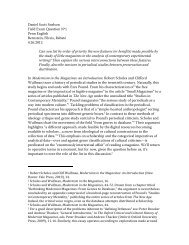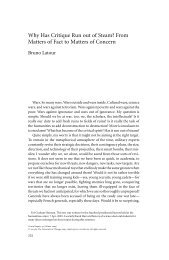The Exploit: A Theory of Networks - asounder
The Exploit: A Theory of Networks - asounder
The Exploit: A Theory of Networks - asounder
You also want an ePaper? Increase the reach of your titles
YUMPU automatically turns print PDFs into web optimized ePapers that Google loves.
156 Coda<br />
<strong>The</strong> level <strong>of</strong> bits and atoms suggests to us not modern physics or<br />
postmodern computing but something totally ancient—an ancient,<br />
even pre - Socratic understanding <strong>of</strong> networks. <strong>The</strong> pre - Socratic question<br />
is a question about the fabric <strong>of</strong> the world. Of what is it made?<br />
What is it that stitches the world together, that links part to part in a<br />
larger whole? <strong>The</strong> answers given, from Thales to Anaxagoras, involve<br />
the elemental. Water, fire, air, “mind,” or some more abstract substance<br />
. . . Heraclitus, for instance, gives us a world in which everything<br />
flows—empires rise and fall, a person remains a person throughout<br />
youth and old age, and one can never step into the same river twice.<br />
For Heraclitus, it is fire that constitutes the world. But he does not<br />
mean “fire” as a denotated thing, for the flame or the sun itself point<br />
to another “fire,” that <strong>of</strong> dynamic morphology, a propensity <strong>of</strong> energentic<br />
flux. This kind <strong>of</strong> fire is more elemental than natural. <strong>The</strong><br />
same can be said for Parmenides, who is now more commonly regarded<br />
as the complement, rather than the opposite, <strong>of</strong> Heraclitus. <strong>The</strong> emphasis<br />
on the “One”—the sphere without circumference—leads Parmenides<br />
to the fullness <strong>of</strong> space, a plenum that emphasizes the interstitial<br />
aspects <strong>of</strong> the world. If everything flows (the statement <strong>of</strong><br />
Heraclitus), then all is “One” (the proposition <strong>of</strong> Parmenides).<br />
A movement between a world that is always changing and a world<br />
that is immobile, between a world that is always becoming and a<br />
world that is full—the movement and the secret identity between<br />
these positions seem to describe to us something fundamental about<br />
networks. <strong>Networks</strong> operate through ceaseless connections and disconnections,<br />
but at the same time, they continually posit a topology.<br />
<strong>The</strong>y are forever incomplete but always take on a shape.<br />
<strong>The</strong> shape also always has a scale. In the case <strong>of</strong> certain network<br />
topologies such as the decentralized network, the scale is fractal in<br />
nature, meaning that it is locally similar at all resolutions, both macroscopic<br />
and microscopic. <strong>Networks</strong> are a matter <strong>of</strong> scaling, but a scaling<br />
for which both the “nothing” <strong>of</strong> the network and the “universe”<br />
<strong>of</strong> the network are impossible to depict. One is never simply inside or<br />
outside a network; one is never simply “at the level <strong>of</strong> ” a network.<br />
But something is amiss, for with fields such as network science and<br />
new forms <strong>of</strong> data visualization, attempts are made to image and manage<br />
networks in an exhaustive sense. <strong>The</strong> impossibility <strong>of</strong> depiction is









